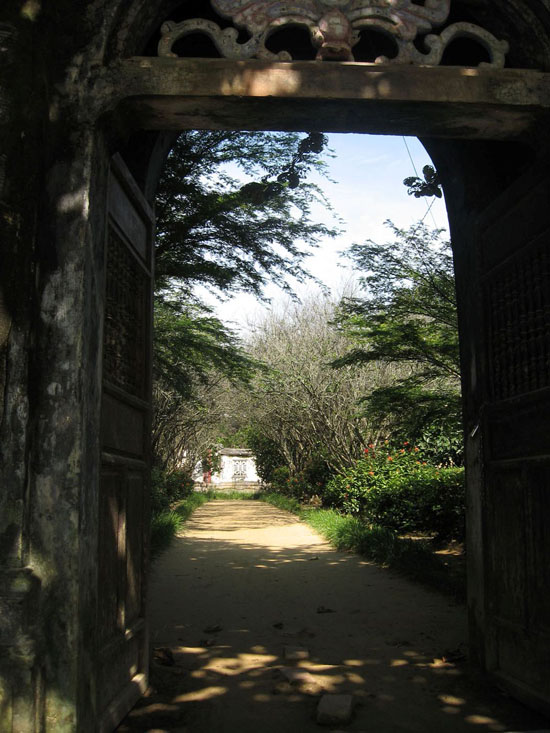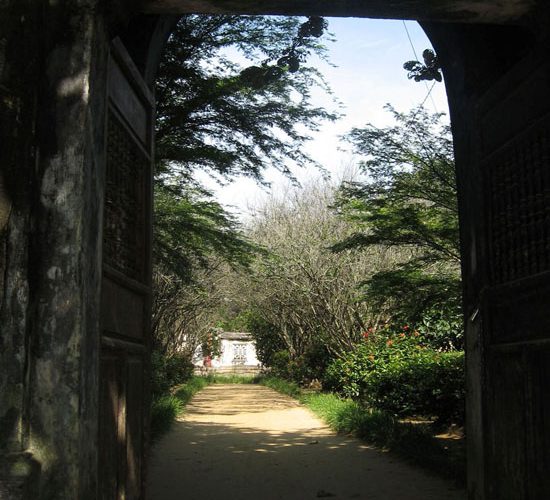(No.3, Vol.3, Apr 2013 Vietnam Heritage Magazine)
Perhaps one of the most impressive, peaceful, and profoundly captivating of things is the tranquil greenness of the numerous ngõ, or entrance paths, of homes and neighbourhoods in Hue.
The small entrance paths meander on as profusely as nostalgia, as if to allow sufficient time for people to contemplate alongside the surrounding fruit trees, as if to interweave nebulous, entangled emotions along the paths of life, as if to allow somebody out there to go on longing for someone with each and every step on the return home some day long ago.
When speaking of green, quiet entrance paths, perhaps Hue is most replete with the verdant enchantment that lends people such idyllic sensations. Having lived in Hue for a long time, I am yet still mystified by the little entrance paths in Hue. I feel as if they were a thread binding the spirit of Hue to life far and wide. The thread is woven with leaves and mist, and intertwined therein are simple echoes from gardens and even the modest light of time, of the landscape and space of Hue. It is all woven together by the hand of a mind full of a sensitivity that is at once silent and mossy and as vibrant as the wind through a bamboo forest.
The people of Hue often say, ‘In the home, out in the entrance path,’ and indeed, an entrance path of a home or a neighbourhood is like the preface of a book or the beginning of a story.

An Hien garden home, Hue.
Photos: Ho Dang Thanh Ngoc
Hue people often consider that in their traditional three-compartment, two-wing homes, the middle compartment is always for venerating the ancestral tablet, the right compartment is for worshiping the earth gods (land and gardens), and that the compartment on the left is the place set aside for the Kitchen God, and for the women who take care of the kitchen. Thus, an entrance path leading up straight towards the middle compartment must be avoided. If the layout offers no choice, then a screen is necessary to block it [from leading directly to the middle compartment]. After that, a connection path must be made that turns towards the right compartment. Only estates of kings, lords, and noble families have an entrance paths leading to the middle compartment. The majority of entrance paths of hundreds of aristocratic estates in Hue are such that the entrance path opens directly towards the middle compartment, while a screen is built at the end to block it. It is taboo for the entrance path to lead directly to the left compartment, where there kitchen is. This arrangement also owes itself to Hue people’s belief that for the entrance path to lead to the right compartment is to esteem guests, while an entrance path leading to the left compartment is for nothing more than for domestic animals (buffalo and cattle) to come and go. Gates are usually roofed so that passers-by may take shelter from the sun and rain.
The way entrance paths are positioned in Hue is a reminder to her folks that, whenever one heads out, there is a right and wrong, a front and back; that whenever one steps out to do business in life towards fame and success, that one not forget the clustered neighbourhood on the very ground that afforded one a home and that one not follow after the world’s expression ‘the homes are near, but the entrance paths are far’ and end up keeping to oneself with one’s gates shut tight and one’s walls towering high.
As a saying goes: ‘Evening after evening, I stand out in the rear entrance path and long for my hometown…’ In the past, Hue girls, when they were married to a far away husband and thus had to live far away from their birth place, often turned to the rear entrance paths to assuage the lamentable fate of becoming a daughter-in-law, their furtive tears falling to the areca trees, to groves of banana, and falling down to the damp, mossy earth.

Kim Long garden home, Hue
Photos: Ho Dang Thanh Ngoc
Beside the entrance paths of homes are those of the neighbourhood. Usually, neighbourhood entrance paths are planted with bamboo and rows of glistening, verdant areca, while home entrance paths are planted with Chinese tea and hibiscus. Whether at the end of a home entrance path where it connects with the neighbourhood or at the end of a neighbourhood entrance path, where it meets the road to the village, there’s always a three-way intersection spacious enough for neighbourhood youngsters to gather and play, a place for adults to meet, share in betel, and converse.
A Vietnamese version of the article was printed on Gia Dinh Xa Hoi magazine of 10 November, 2012.

